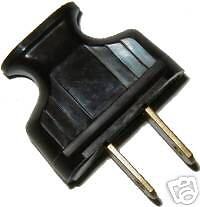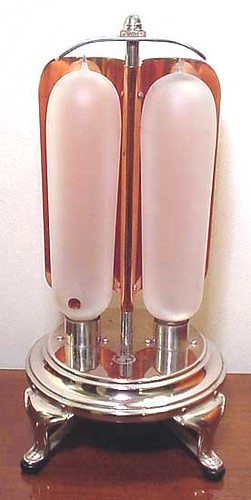Forgotten Man
One Too Many
- Messages
- 1,944
- Location
- City Dump 32 E. River Sutton Place.
Well, some of you have seen some interesting and unique space heaters I'm sure at antique shops, thrift shops and swap meets... and most people who see them instantly think: OMG, I could never use one of those, they'd burn the house down!
The common misconception is that old electrical appliances can result in an electrical fire or short out the house... this can happen only if:
The power cord is tattered or broken.
The plug is cracked or chipped or seriously corroded.
The connectors inside are not properly attached or are corroded.
The heating filament is broken.
These little heaters are much like the common house hold counter top toaster, they work off of the same principal. I have a few of these old space heaters my self and I use them as long as it is safe to do so.
Now, if one looks at the power cord to a heater, it's much the same as a toaster cord... copper wire with rubber and cotton cloth weave. The plugs are either rubber or bakelite. Now, even if the cord looks fine, it's best to test it and one can do this by plugging in the heater, let it heat up for a bit, feel the plug and cord... if the plug and cord remains cool after the heater has heated up all the way, then, you're looking at a good and reliable heater. If the plug or cord gets hot, that means there's a break in the copper wire somewhere and then, it should be replaced.
To replace a cord is easy... however requires some soldering. Also, you'd want to use a heavy cord since these heaters do draw a healthy amount of current. You can find good period appropriate heater cord on ebay or I could contact my friend who carries the stuff. The cloth covered stuff may seem dangerous but, it works fine because, it's over rubber insulation.
Most heaters of the times had rubber plugs attached permanently to the cord, now, if one replaces the cord, they will have to use a different plug... and believe it or not, bakelite plugs are everywhere on ebay! The classic early "Button" or "Wall hugger" styles are appropriate for early 20's to 30's types:

and then more streamlined 40's to 50's sets used more of a flat "Streamlined" style like this:

These are safe to use, Bakelite can take a lot of heat... and as long as the prongs are clean, they'll do the job just as well as a modern one.
Now for those who do want a vintage heater, and one is found in an antique shop, and it looks to be in good shape, have an employee assist you and plug it in... and test it out... they usually are pretty happy to help with that kind of stuff. Watch it and test the cord or plug and see if it warms up or stays cool. If it stays cool and the price is right, go for it! They do come in handy on those chilly nights. Now, they were designed only as a space heater, they will not warm up an entire house or large room... Bedrooms or bathrooms are appropriate for space heaters. And just like any heating type of appliance, do not ever leave it on wile you sleep or are away for a long period of time.
If a heater is found that is missing the cord, or is rusty, corroded or looks like too much work... there's three things to do; one is to pass on it till you find another one that's in better condition; two is to buy it and restore it; three is to take a picture and email me the photo! I may just want to buy it... lol
If anyone has questions or input, by all means ad something interesting or fun to this thread!
The common misconception is that old electrical appliances can result in an electrical fire or short out the house... this can happen only if:
The power cord is tattered or broken.
The plug is cracked or chipped or seriously corroded.
The connectors inside are not properly attached or are corroded.
The heating filament is broken.
These little heaters are much like the common house hold counter top toaster, they work off of the same principal. I have a few of these old space heaters my self and I use them as long as it is safe to do so.
Now, if one looks at the power cord to a heater, it's much the same as a toaster cord... copper wire with rubber and cotton cloth weave. The plugs are either rubber or bakelite. Now, even if the cord looks fine, it's best to test it and one can do this by plugging in the heater, let it heat up for a bit, feel the plug and cord... if the plug and cord remains cool after the heater has heated up all the way, then, you're looking at a good and reliable heater. If the plug or cord gets hot, that means there's a break in the copper wire somewhere and then, it should be replaced.
To replace a cord is easy... however requires some soldering. Also, you'd want to use a heavy cord since these heaters do draw a healthy amount of current. You can find good period appropriate heater cord on ebay or I could contact my friend who carries the stuff. The cloth covered stuff may seem dangerous but, it works fine because, it's over rubber insulation.
Most heaters of the times had rubber plugs attached permanently to the cord, now, if one replaces the cord, they will have to use a different plug... and believe it or not, bakelite plugs are everywhere on ebay! The classic early "Button" or "Wall hugger" styles are appropriate for early 20's to 30's types:
and then more streamlined 40's to 50's sets used more of a flat "Streamlined" style like this:
These are safe to use, Bakelite can take a lot of heat... and as long as the prongs are clean, they'll do the job just as well as a modern one.
Now for those who do want a vintage heater, and one is found in an antique shop, and it looks to be in good shape, have an employee assist you and plug it in... and test it out... they usually are pretty happy to help with that kind of stuff. Watch it and test the cord or plug and see if it warms up or stays cool. If it stays cool and the price is right, go for it! They do come in handy on those chilly nights. Now, they were designed only as a space heater, they will not warm up an entire house or large room... Bedrooms or bathrooms are appropriate for space heaters. And just like any heating type of appliance, do not ever leave it on wile you sleep or are away for a long period of time.
If a heater is found that is missing the cord, or is rusty, corroded or looks like too much work... there's three things to do; one is to pass on it till you find another one that's in better condition; two is to buy it and restore it; three is to take a picture and email me the photo! I may just want to buy it... lol
If anyone has questions or input, by all means ad something interesting or fun to this thread!






